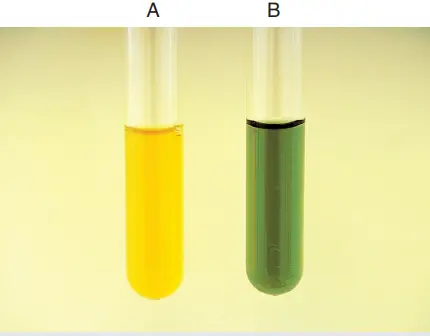Advertisements
Table of Contents
- The capability of an organism to utilise the substrate pyruvate can be tested with Pyruvate Broth.
- Those organisms that can metabolise pyruvate can be distinguished from those that can’t thanks to the presence of the test substrate pruvate. The ability to distinguish between Enterococcus faecalis and Enterococcus faecium relies on this trait.
- The broth made from pyruvate has a low nutritional content and no carbohydrates.
- Metabolic acids are formed when pyruvic acid is given to the broth to test for the microorganism’s pyruvate utilisation capability.
- As the pH drops in an acidic environment, the colour of the bromothymol blue indicator changes from blue to yellow.
Pyruvate Broth Test Purpose
- To ascertain whether or not an organism can utilise pyruvate, this test is performed.
- This helps distinguish between Enterococcus faecium (negative) and Enterococcus faecalis (positive) (negative).
Pyruvate Broth Test Principle
- The capacity of bacteria to produce organic molecules via the metabolism of specific carbohydrates and related chemicals is a common technique for microbial identification.
- The broth made from pyruvate has a low nutritional content and no carbohydrates.
- Bromothymol blue, sodium pyruvate, dipotassium phosphate, yeast extract, and casein peptone are some of the ingredients in pyruvate broth.
- Sodium chloride keeps the osmotic balance, while casein peptone and yeast extract supply the growth nutrients and components.
- The fermentable element is sodium pyruvate, while the buffering system is dipotassium phosphate.
- The acid-base indicator, bromothymol blue, is a greenish-blue colour at neutral pH and a yellow colour once acid is created from pyruvate fermentation.
- The pH indicator bromothymol blue can detect metabolic acids, produced when the active substrate pyruvate is broken down by organisms that can use it.
- When more acid is produced, the medium’s pH drops, and the hue changes.
- When a enough amount of acid is produced, the medium’s hue shifts from blue-green to yellow. There is no noticeable change in hue as a result of the adverse reaction.
Requirement
- Media: Pyruvate Broth is required for this test.
- Inoculum
Pyruvate Broth Composition
| Pancreatic digest of casein | (10 gm/L) |
| sodium pyruvate | (10 gm/L) |
| yeast extract | (5 gm/L) |
| NaCl | (5 gm/L) |
| dipotassium Phosphate | K2HPO4 (5 gm/L) |
| bromothymol blue | (0.04 gm/L) |
pH 7.3 +/- 0.2 at 25ºC.
Pyruvate Broth Test Procedure
- Add a small amount of the organism grown on 5% sheep blood agar for 18 to 24 hours to the pyruvate broth.
- Incubate at 35°–37°C for 24–48 hours in normal air.
- Check for a yellow response.
Expected Results of Pyruvate Broth Test
- Positive Pyruvate Broth Test Result: The indicator goes from green to yellow.
- Negative Pyruvate Broth Test Results: No change in colour; yellow-green means a weak reaction and should be taken as a negative result.

Quality Control
- Positive: Enterococcus faecalis ATCC29212
- Negative: Enterococcus faecium ATCC 6569, Streptococcus bovis ATCC9809
Pyruvate Broth Test Uses
- Enterococcus faecalis (which is positive) and Enterococcus faecium (which is negative) can be told apart by this test (negative). Several other species that can use pyruvate as a part of an identification test can be found using this method.
Limitations
- For full identification, it is suggested that biochemical, immunological, molecular, or mass spectrometry tests be done on colonies from pure culture.
References
- Tille P.M. 2014. Bailey and Scott’s diagnostic microbiology. Thirteen editions. Mosby, Inc., an affiliate of Elsevier Inc. 3251 Riverport Lane. St. Louis. Missouri 63043
- https://www.studocu.com/en-gb/document/university-of-salford/biology/lecture-notes-the-pyruvate-broth-test/16079242
- https://himedialabs.com/TD/M1688.pdf
- https://microbiologyinfo.com/pyruvate-broth-test/
- http://www.uwyo.edu/molb2021/additional_info/summ_biochem/glucose_broth.html
